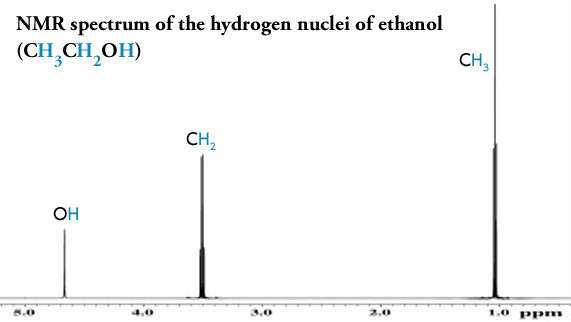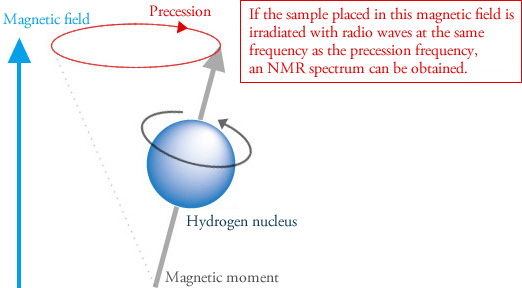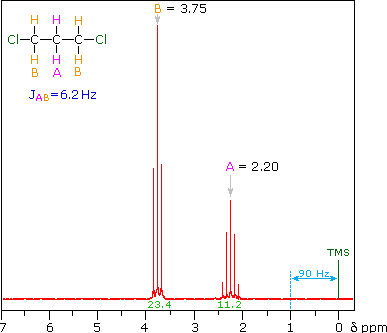Two common types of NMR spectroscopy are used to characterize organic structure. Solid-state Nuclear Magnetic Resonance Spectroscopy is a powerful technique used in analyzing the structural chemical and physical properties of pharmaceuticals solids.

Nmr Basic Knowledge Nuclear Magnetic Resonance Spectrometer Nmr Products Jeol
Carbon-13 has a nuclear spin I ½ and makes up 11 of all naturally occurring carbon a high enough abundance along with.

. Magnetic resonance imaging MRI and magnetic resonance spectroscopy MRS. Nuclear Magnetic Resonance Spectroscopy tutorial all along with the key concepts of Basic Principle of NMR The Source of NMR Spectra NMR spectrum Pattern of the Spectrum The. Hornak is Professor of Chemistry and Imaging Science at the Rochester Institute of Technology where he teaches courses in magnetic resonance imaging nuclear magnetic resonance spectroscopy analytical chemistry and physical chemistry.
Pure compounds are generally required for unambiguous analysis and accurate structure elucidation. In NMR magnetic nuclei of specific isotopes are aligned by a strong external magnet and then perturbed by a radio wave. No other technique has gained such significance as NMR spectroscopy.
Nuclear Magnetic Resonance Spectroscopy. 13 C Nuclear Magnetic Resonance Spectroscopy Tutorial Key Concepts. Nuclear Magnetic Resonance NMR Spectroscopy.
NMR Spectroscopy - NMR Nuclear Magnetic Resonance - An nmr spectrum is acquired by varying the magnetic field over a small range while observing the rf signal from the sample. These moments are in nuclear magnetons which are 50507810-27 JT-1. Nuclear Magnetic Resonance Spectroscopy tutorial all along with the key concepts of Basic Principle of NMR The Source of NMR Spectra NMR spectrum Pattern of the Spectrum The NMR spectrometer Operational procedure Application of NMR.
Nuclear Magnetic Resonance NMR Spectroscopy is a powerful analytical technique that can reveal structural information about many organic and inorganic molecules. Nuclear magnetic resonance spectroscopy tutorial. The height of each step is proportional to the area under the resonance.
The nuclei of many elements such as 13 C spin generating a magnetic field. NMR is the confirmatory technique for structural analysis of unknown compounds especially small organic molecules. The applications of MRS as a research tool are extremely diverse encompassing studies on isolated cells body fluids and perfused organs at high magnetic field strengths in an experimental.
The SCSB NMR Laboratory is located in its own two-story. Wileyplus Nmr Spectroscopy And Nuclear Spin - An nmr spectrum is acquired by varying or sweeping the magnetic field over a small range while observing the rf signal from the sample. 2 6 integral d 36 d 12 The relative area under the resonances at d 36 and 12 is 13 The integral is superimposed over the spectrum as a stair-step line.
Apart from the molecular structure NMR spectroscopy can determine phase changes conformational and configurational alterations solubility and diffusion potential Krishnan 2019. H0 is magnetic field which separates the energy into two. Nuclear magnetic resonance spectroscopy is a powerful analytical technique used to characterize organic molecules by identifying carbon-hydrogen frameworks within molecules.
Nuclear magnetic resonance NMR spectroscopy is one of the most powerful and versatile analytical techniques that can be applied to liquid andor solid materials and has become increasingly popular in the field of food science for the evaluation and the analysis of several foods such as beverages oils and lipids. Nuclear magnetic resonance NMR is a spec- troscopic technique that detects the energy ab- sorbed by changes in the nuclear spin state. E2 12 γh 2Π H0.
It is used to determine the molecular structure at the atomic level of a sample. The biomedical applications of nuclear magnetic resonance NMR are twofold. 193 Liquid chromatography-nuclear magnetic resonance spectroscopy.
Nuclear magnetic resonance NMR spectroscopy is an advanced characterization technique. A powerful technique useful for identifying the small to the very large When some atoms are placed in a strong magnetic field their nuclei behave. Nuclei with an odd mass or odd atomic number have nuclear spin in a similar fashion to the spin of electrons.
Nuclear Magnetic Resonance NMR Spectroscopy is not limited to the study of protons. Copyright 1997-2019 JP. There are two major relaxation processes.
The area under an NMR resonance is proportional to the number of nuclei that give rise to that resonance. Additionally the samples set for analysis requires no special preparation. In case of polymers NMR has been used to study reaction kinetics and chemical.
Nuclear magnetic resonance NMR spectroscopy explores the electronic environment of atoms. Nuclear magnetic resonance NMR spectroscopy is a versatile tool that provides information on structures and dynamics of various biological and synthetic molecules at an atomic level. One is 12 which is anti-parallel to the magnetic field and the other is 12 which is parallel to the magnetic field.
1 H μ 27927 19 F μ 26273 31 P μ 11305 13 C μ 07022. The application of NMR spectroscopy to the study of proteins and nucleic acids has provided unique in- formation on the dynamics and chemical kinetics of these systems. Welcome to the WSU Center for NMR Spectroscopy To combat the spread of COVID-19 effective September 8 2021 there is a more stringent procedure for using the NMR lab.
For the four common nuclei noted above the magnetic moments are. Any element with a nuclear spin 13 C 17 O 19 F 31 P and many others will give rise to an NMR signal. This external energy applied to the molecule is absorbed and the perturbed nucleus is.
Carbon Nuclear Magnetic Resonance 13C-NMR Spectroscopy. Mass spectrometry MS is an analytical technique that is used to measure the mass-to-charge ratio of ionsThe results are presented as a mass spectrum a plot of intensity as a function of the mass-to-charge ratioMass spectrometry is used in many different fields and is applied to pure samples as well as complex mixtures. Nuclear Magnetic Resonance Spectroscopy or NMR Spectroscopy can be used to identify any isotope unless the isotope has both an even number of protons and an even number of neutrons.
1H NMR is used to determine the type and number of H atoms. Nuclear Magnetic Resonance Spectroscopy Tutorial. The following diagram gives the approximate frequencies that correspond to the spin state energy separations for each of these nuclei in an external magnetic field of 235 T.
The technique is non-invasive and non-destructive Tishmack Bugay Byrn 2003pg 92.

Basic Introduction To Nmr Spectroscopy Youtube

Analytical Chemistry A Guide To Proton Nuclear Magnetic Resonance Nmr Compound Interest

Nmr Basic Knowledge Nuclear Magnetic Resonance Spectrometer Nmr Products Jeol




0 comments
Post a Comment